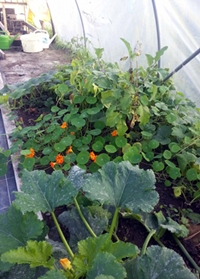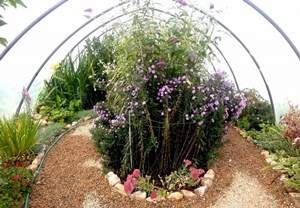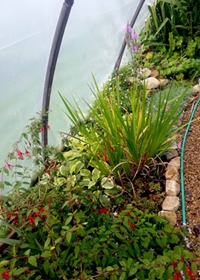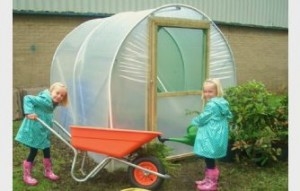![]()
From time to time I receive requests from people asking if they can guest blog on the Greenside Up website and in general I’ve declined but an enquiry a few weeks ago from Adrian Berry of Premier Polytunnels was written so politely and on a subject I was about to post myself, I was more than happy for a polytunnel expert to write it for you!
It’s always preferable to support and shop locally but although I write largely for an Irish audience, I know that almost as many of you looking at my blog are doing so from the UK. The link for this particular Lancashire supplier is therefore for you!
Although Premier are more than happy to supply and deliver polytunnels to Ireland, we already have some good, competitive and friendly suppliers living here. Gillespie Polytunnels in Donegal and Highbank Polytunnels in Kilkenny have both been great friends of community garden projects and Polydome in the midlands are very popular too.
For now though, here’s some useful tips from Adrian…

Spot the powdery mildew appearing on courgette leaves indicating the end of season
Polytunnel growing during the autumn and winter months
As autumn begins to set in, some of the gardening community are beginning to check their soggy borders as they contemplate a long winter with very little growing to enjoy.
Not so for those who’ve been fortunate enough to have invested in a polytunnel. Polytunnel gardening is not only a wonderful way to enjoy an extended growing season but it’s also a great route into organic growing.
Due to the enclosed space within a polytunnel, many gardeners choose to add raised beds for their growing purposes rather than digging straight into the earth; it’s only a hop, skip and a jump from there to choosing organic compost and investing in organic seeds. Yes, organic costs a little more in general but you’re benefiting from ultra healthy produce as well as the knowledge that your efforts are helping a little towards keeping the earth and her insect inhabitants safer.
Pallets may not always be the best idea in an organic garden
Raised beds are simple to construct if you’d like to keep things at a low-cost and as long as you take care with the timber you utilise then your DIY beds should be just as effective as the commercially made versions.
If you are planning to upcycle old timber for your raised beds, do take care before repurposing old pallets; this has been a popular and cost-saving strategy for many people recently but it’s not always the best option.
Try to ascertain what type of goods were carried on the pallets before you start growing your precious organic produce in them as many pallets are coated with chemicals during construction or have been contaminated by their loads. It is more advisable to buy good quality, fresh timber for building your own raised beds.
Once your beds are in place, fill with a mixture of good quality organic compost and then dig in some well-rotted manure. The manure isn’t essential but it will really assist your young plants as they establish themselves.

Ornamental Polytunnel at The Organic Centre, Leitrim
Winter…the busy season for polytunnels!
Autumn and winter see a hive of activity in polytunnels all over Ireland and the UK. Whilst the temperature may be dropping and the wind chill factor rising, all is safe, warm and secure in polytunnels and keen organic gardeners know that now is the time to sow seedlings and prepare to reap the benefits with beautiful, early crops in spring.
What can you sow in the polytunnel for the winter months?
Winter is classically a time for root vegetables but you can supplement your winter harvest with winter salads, sowed straight after harvesting your final summer crops such as tomatoes and cucumbers. Winter Lettuce such as Valdor can be sowed in September and harvested right through from November to March. Spring Onions including White Lisbon and Winter Hardy are perfect for the winter months as you can sow them in June. Radishes such as Rosa, Minowase and China Rose can be sown from July to October. Spinach can be sown right through the winter months and you can use the young leaves for winter salads.
Start to raise young plants in modules so they get a head start and plant out when space becomes available.
Tricks for keeping polytunnels warmer during the winter months
In order to help your crops stay safe and warm, there are a few tricks to employ which will help keep the temperature inside your polytunnel above freezing.
A very effective way to grab some free heat is to secure some large rocks around the perimeter of the interior of your polytunnel…one placed at regular two feet intervals along both sides of the tunnel will suffice; the rocks will absorb the precious winter sunlight and retain this heat helping to raise the temperature on the coldest days.
Another handy trick is to pop a large water butt inside your tunnel if you have enough room; the water will retain precious heat on sunnier winter days and when it comes to the coldest months every little helps!
Weed and insect management
Because polytunnels are in effect a tiny eco system in their own right, as a gardener you are in the unique position of being able to control the pest and weed population by hand from the early days of your polytunnel’s life without resorting to nasty chemical sprays.
In the spring and summer, when seeds begin to blow into your polytunnel, stay on top of their growth by removing tiny plants before they flower and spread their progeny! The population of weeds in a polytunnel will already be much less than in a conventional garden so you can stay on top of them by hand with much more ease than you might be able to in an open vegetable garden.
Insects do enter polytunnels, attracted by the scent, warmth and colour and you can help keep them down by ensuring that your polytunnel is well aerated and by removing creepy crawlies by hand as you spot them. Nasties like caterpillars can be discouraged with netting over doors which will stop butterflies from popping in to lay their eggs!

Doesn’t Just Have to Be About Vegetables – Organic Ornamentals in a Polytunnel
Crops to start in autumn
September and October are good for planting potatoes, radish, rocket, spinach, carrots and broad beans. Harvesting won’t be for a few months but your organic crops will be far ahead of where they would be without a polytunnel! As the season moves on into winter, you can begin planning your next crops…in February you can look at planting tomatoes, sweet potatoes, celery, cauliflower and aubergines and bask in the knowledge that your crops will be not only organic but also plentiful!
Throughout the year, polytunnels remain productive and busy as long as you stay on top of them…and there’s something rather pleasing about tending to your tomatoes on a chilly February morning, safe in the confines of your toasty warm polytunnel!”

Premier PolytunnelPremier Polytunnels are specialist manufacturers & suppliers of commercial / garden polytunnels, fruit cages & accessories based in the UK at Barnoldswick, Lancs.
I hope you enjoyed that post. I picked up some good tips from it particularly as I’d never heard about keeping the large stones inside my polytunnel to attract heat or the big tub of water! If there are any other subjects that you might like to read that will help you on your growing journey, just leave a comment below and I’ll see what I can do

Dee Sewell – a horticulturalist and certified trainer who started Greenside Up in 2009 and teaches people how to grow vegetables. Dee specialises in working with community gardens but also offers workshops, allotment visits, consultations, horticultural therapy, afterschools clubs as well as local talks – she tailors her services to meet clients needs. In 2012 Dee launched a Seed Gift Collection containing varieties of vegetable and insect friendly flowers with the aim of getting more people growing. Dee’s blog was a finalist in the 2012 Ireland Blog Awards in the Eco/Green and Lifestyle Categories.
Source: GreenSideUp – Polytunnels & Organic Growing During the Autumn & Winter Months – Dee Sewell




